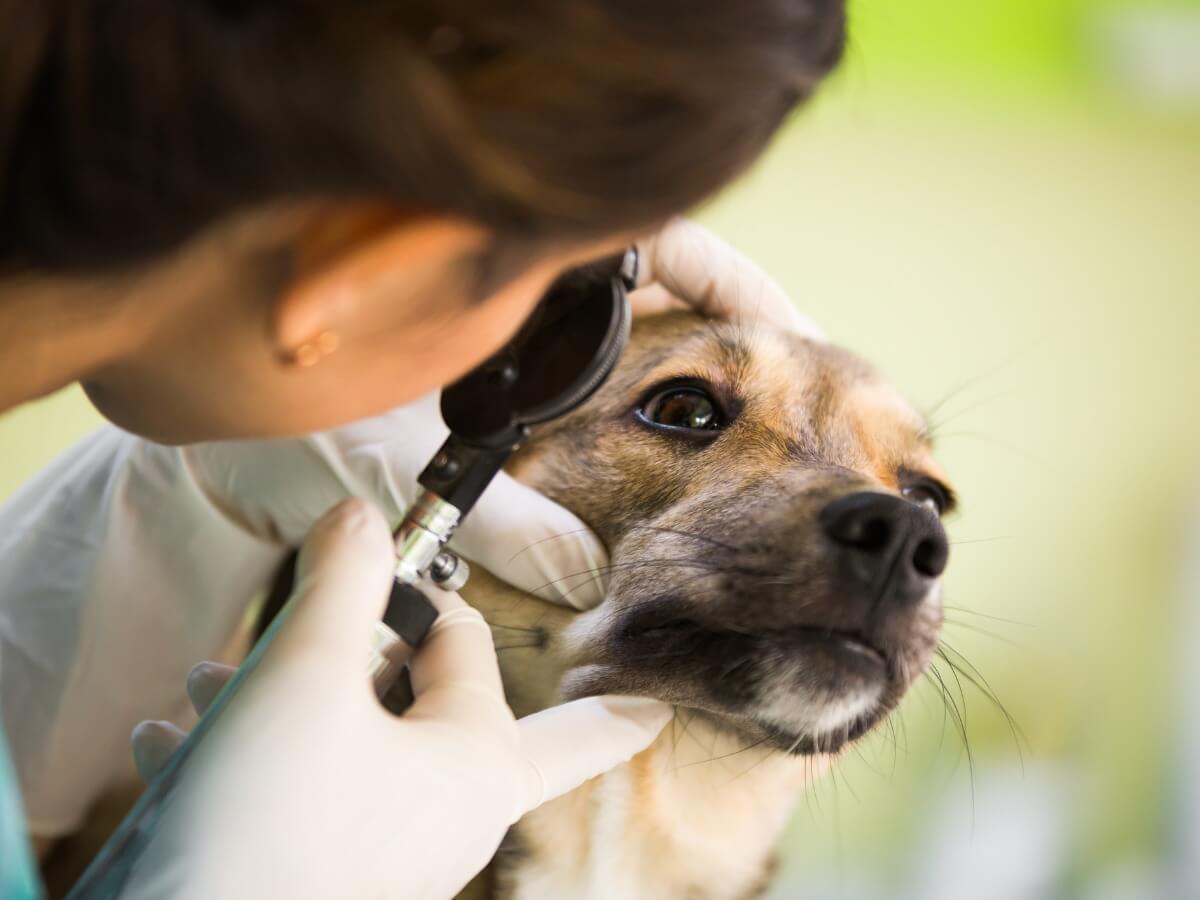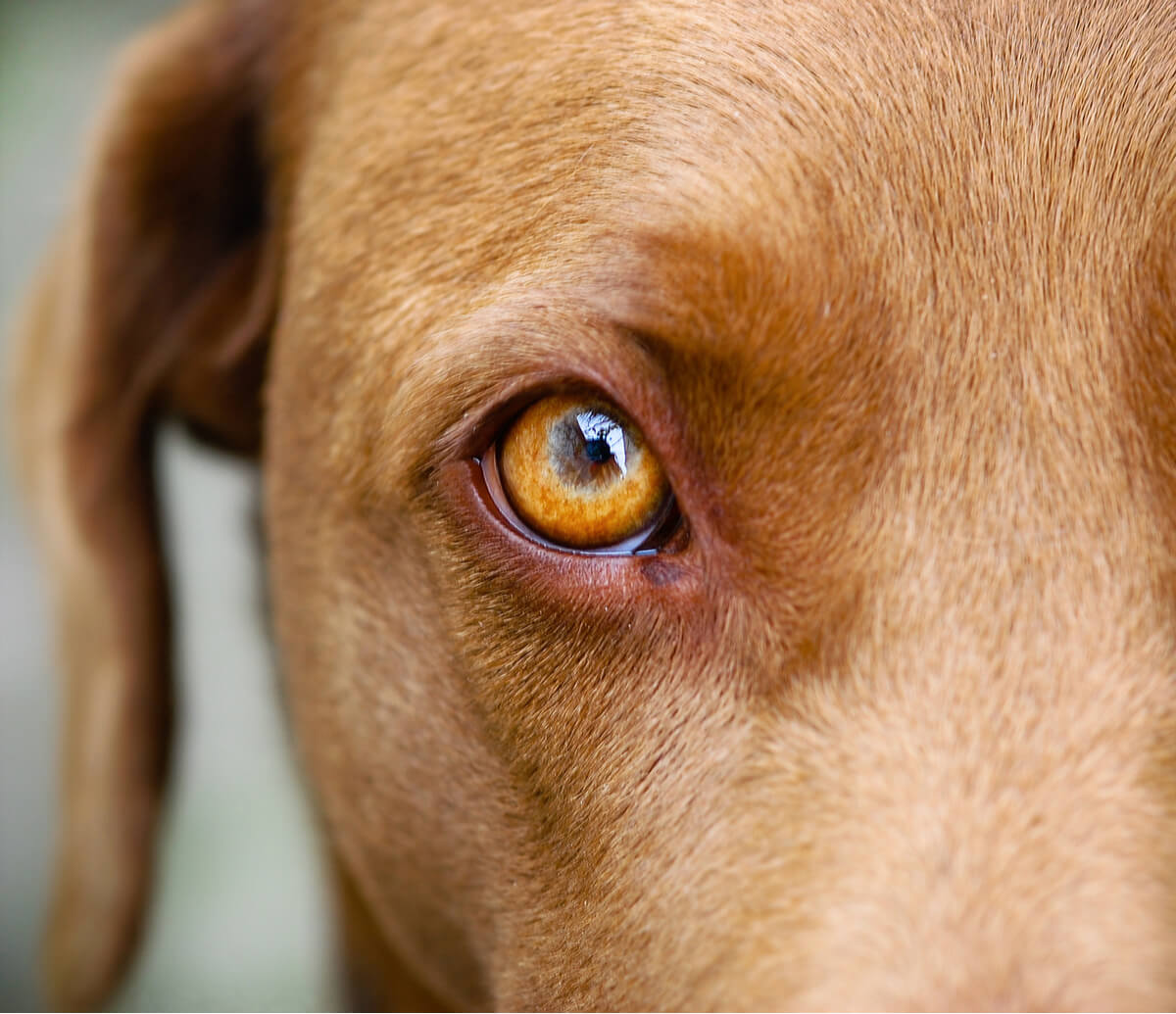My Dog Has a Red Swollen Eye: 10 Causes and Treatments


Written and verified by the biologist Samuel Sanchez
The eyes of other mammals are quite similar to those of the human species in terms of morphology. For the same reason, other living beings develop eye problems similar to those of Homo sapiens, such as cataracts, glaucoma, conjunctivitis, and other pathologies. Here we’ll tell you 10 reasons why your dog has a red swollen eye and what you should do about it.
From direct trauma to inflammation of the conjunctiva, many conditions can compromise the integrity of the canine eye. Some of them are temporary and easy to address, while others can trigger irreversible blindness. If you want to know all the possible reasons for this condition, read on.
1. Conjunctivitis
The term conjunctivitis refers to the inflammation of the conjunctiva, a mucous membrane that covers the ocular sphere and which is involved in the formation of tears and various immunological processes. When an endogenous or exogenous stressor affects this structure, the connective membranes appear red and swollen.
The dog with conjunctivitis will have one (or both) eyes swollen, red, and possibly present with purulent discharges in the tear duct. They’re also likely to blink excessively and develop mucus, coughs, and nasal discharge. Within this condition, we can distinguish several variants.
1.1 Viral conjunctivitis
Some viruses such as distemper (canine distemper virus) are capable of causing conjunctivitis in dogs. In addition to this, they can also create corneal ulcers, corneal edema (blue eye), dry keratitis and many other symptoms outside the eyes, in the digestive system, the skin, and the respiratory system, for example.
Viral symptoms don’t usually have a specific treatment. It’s enough to reduce the animal’s symptoms pharmacologically and hope that that alone can combat the condition.
1.2 Bacterial conjunctivitis
As studies indicate, up to 40% of dogs are carriers of bacterial species in their eyes, even if they don’t show clinical signs. Most canine bacterial conjunctivitis is caused by microorganisms of the genus Streptococcus and Staphylococcus, and although it’s a rare infection, it spreads very quickly.
In these cases, there are standardized treatments. Gentamicin, tobramycin, chloramphenicol, oxytetracycline, ciprofloxacin, or triple antibiotic ointments and ophthalmic solutions are commonly prescribed. Sometimes the vet will also include anti-inflammatory drops and ointments in the treatment process.
1.3 Autoimmune conjunctivitis
Your dog may have a red swollen eye due to autoimmune conjunctivitis. This means that it comes from the malfunction of their immune cells and other protective mechanisms. One of its most common variants is the plasma cell type. In these cases, blood cells infiltrate the ocular environment and attack it.
This condition occurs mostly in German Shepherds.

2. Foreign objects
Dogs can easily suffer damage to the cornea and the ocular environment from the presence of a foreign body. When out on a walk, they spend a large part of their time sniffing and getting closer to the ground, so their eye apparatus is usually quite exposed to the entry of external material into the area.
If something becomes encrusted, the dog may have a red swollen eye, excessive tearing and obvious itching. The veterinary portal Lort Smith teaches us to act in a situation like this:
- Rinse the dog’s eye with a specific eye solution or with normal water, always using a wide-mouth syringe.
- If the object doesn’t dislodge, use specific gels for dogs based on sterile water and then try rinsing again. Use a flashlight to check that you have effectively gotten rid of the annoying element.
- If the dog still has a red swollen eye, put an Elizabethan collar on them. This will prevent the eye area from getting further damaged by its paws.
- Seek veterinary help immediately.
3. Glaucoma
In both humans and dogs, glaucoma is characterized by increased intraocular pressure (IOP). In these cases, the eye isn’t able to properly drain fluids, so they accumulate in certain areas and pressure forces are exerted on structures that are essential for sight. Over time, the optic nerve becomes irreversibly damaged.
A dog with glaucoma will show a red, swollen, and glassy eye, as if an opaque film had been placed over its cornea. Pain relievers and medications that promote eye discharge should be prescribed as soon as possible, because, if you do not act quickly, the dog can go irreversibly blind.
4. Uveitis
Unlike conjunctivitis, in which the conjunctiva becomes inflamed, here there’s an inflammation of the uvea, the middle layer of the eye. In turn, this complex structure is made up of the iris, the ciliary body, and the choroid. One or more parts of this system can be affected by uveitis.
Like conjunctivitis, this condition can be caused by various etiological agents. Next, we’ll briefly show you some of the most important ones, according to their place of origin.
4.1 Exogenous uveitis
The cause is “outside” the canid’s eye system. This category includes inflammation of the uvea due to a direct blow to the eye and corneal ulcerations, whether due to the presence of a foreign object or another cause.
4.2 Endogenous uveitis
The cause is within the dog’s biological system. The pathology may have developed within the eye or, failing that, have its origin in another organ and manifest itself in one way or another in the ocular environment. Certain viral and bacterial agents that we have already reviewed can cause endogenous uveitis.
Depending on the causative agent, the clinical approach will vary greatly in each case. From antibiotics to anti-inflammatories, this condition can be addressed in many ways.
5. Direct trauma
Your dog’s eye may appear red and swollen simply because of a direct bump in the area. As indicated by medical portals, inflammation in vertebrates aims to isolate damaged tissue and repair it as much as possible, and so it’s common for this clinical sign to appear after a strong blow.
Following an inflammatory response in almost any tissue, any of the following can occur:
- Resolution of tissue stress with a return to normal functionality.
- Suppuration with abscess formation.
- Swelling, with regeneration of specialized or fibrous tissue. This results in the famous scars.
- Persistence of the damage, which favors the transition to a chronic condition.
Depending on the force of the blow and the causative agent, short-term or long-term veterinary treatment may be necessary. However, if your dog has a red swollen eye after an injury and this doesn’t resolve in a few hours, don’t hesitate to go to the vet.
6. Ectropion
Ectropion is a canine disease in which the eyelid moves outward, exposing the interior structures of the eye. This condition promotes infections in the affected eye, as bacteria and other parasites can more easily come into contact with the ocular mucosa.
7. Entropion
In this case, there’s an inversion of the edges of the eyelid towards the inside of the eye. This causes the eyelashes to rub against the cornea, which favors the appearance of corneal ulcers, redness, pain, and a gradual loss of vision. In the most serious conditions, immediate surgery is required.

We have brought you 10 reasons why your dog may have a red swollen eye, but they aren’t the only ones. If you have any questions, or if your dog manifests any of the symptoms that we’ve mentioned, then don’t hesitate to go to the vet promptly. To maintain a dog’s long-term visual health, every second counts.
All cited sources were thoroughly reviewed by our team to ensure their quality, reliability, currency, and validity. The bibliography of this article was considered reliable and of academic or scientific accuracy.
- Prado, M. R., Rocha, M. F., Brito, É. H., Girão, M. D., Monteiro, A. J., Teixeira, M. F., & Sidrim, J. J. (2005). Survey of bacterial microorganisms in the conjunctival sac of clinically normal dogs and dogs with ulcerative keratitis in Fortaleza, Ceará, Brazil. Veterinary ophthalmology, 8(1), 33-37.
- Foreign body in the eye of dogs, Lort Smith. Recogido a 9 de julio en https://lortsmith.com/need-help-now/dog/injury-trauma/foreign-body-in-the-eye-in-dogs/#:~:text=Flush%20the%20eye%20with%20a,the%20foreign%20body%20is%20removed.
- Violette, N. P., & Ledbetter, E. C. (2019). Lipemic uveitis and its etiologies in dogs: 75 cases. Veterinary ophthalmology, 22(5), 577-583.
- Mimura, T., Noma, H., & Mizota, A. (2019). Specific Dog Allergen Immunoglobulin G Antibodies in Patients with Allergic Conjunctivitis. The Open Ophthalmology Journal, 13(1).
This text is provided for informational purposes only and does not replace consultation with a professional. If in doubt, consult your specialist.